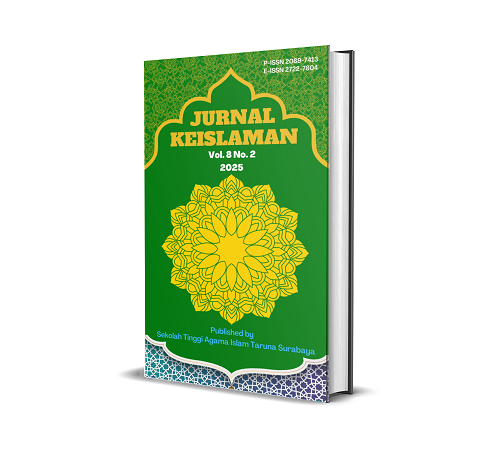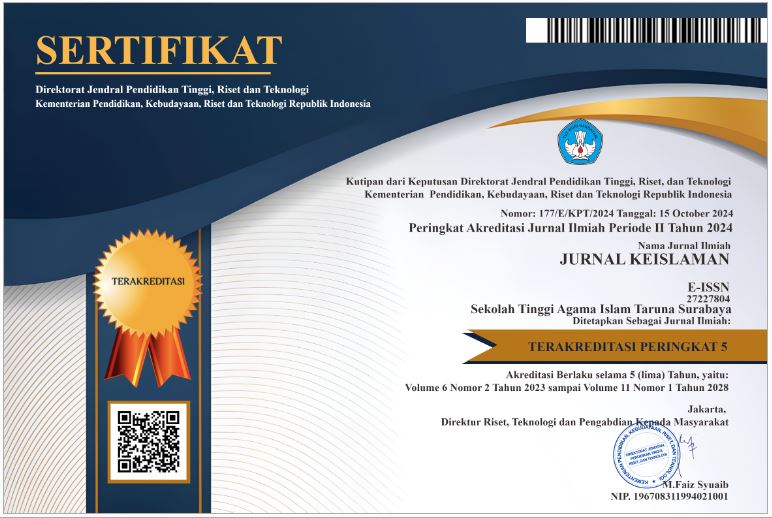Qirâ’ah al-Kutub: Kajian Teoretis Berbasis Semantik Kontekstual pada Mahasiswa Studi Keislaman
DOI:
https://doi.org/10.54298/jk.v8i2.657Keywords:
Qirâ’ah al-Kutub, contextual semantics, mufradât, Islamic studies students, Fath al-QaribAbstract
This study examines Qirâ’ah al-Kutub learning for Islamic studies students using a contextual semantic theory approach, aimed at enhancing the deep understanding of classical texts. The focus of this research is the analysis of Fath al-Qarib by Shaykh Muhammad bin Qasim Al-Ghaziy, particularly on the theme of al-Zawâj (marriage). The contextual semantic approach emphasizes the importance of language, situational, emotional, and cultural contexts in interpreting mufradât and sentence structures, ensuring students’ understanding is not merely lexical but holistic. This research employs a qualitative-theoretical method, involving literature studies of classical texts and scholarly references on contextual semantics and Qirâ’ah al-Kutub learning. The results indicate that the application of contextual semantic theory facilitates students in identifying key mufradât, understanding variations in word meanings, and relating classical texts to Islamic family law practices. The study also demonstrates that contextual approaches strengthen students’ analytical, interpretive, and critical reflection skills. These findings confirm that integrating contextual semantic theory in Qirâ’ah al-Kutub learning is an effective strategy for developing comprehensive classical text comprehension skills and serves as a crucial foundation for advancing Arabic language instruction and Islamic studies.
Downloads
References
‘Aun, N. (2005). al-Alsuniyyah Muhâdharât fî ‘Ilm al-Dilâlah (1st ed.). Dâr al-Farâbî.
Alif, A. F., & Munirul, A. (2023). Hubungan Penguasaan Sintaksis dan Morfologi Arab Terhadap Pemahaman Isi Teks-Teks Arab Dalam Kitab Klasik di Pondok Pesantren Al-Mukhlisin Batu. Lisanuna: Jurnal Ilmu Bahasa Arab Dan Pembelajarannya, 13(1), 114–129. https://doi.org/https://doi.org/10.22373/ls.v13i1.18034
Bahri, S. (2016). Peran Al-Siyaq (Konteks) Dalam Menentukan Makna. Ittihad Jurnal Kopertais Wilayah XI Kalimantan, 14(26), 88.
Bahri, S. (2025). Pembelajaran Mufradat Berbasis Konteks (Siyaq) Bagi Pembelajar Non-Arab. Fasahah: Jurnal Pendidikan Bahasa Arab, 02(01), 41–51. https://doi.org/https://doi.org/10.62748/fasahah.v2i01.281
Bisri Mustofa, N. A., & I. R. (2025). Improving Students’ Reading Skills Through The Development Of Digital Nahwu Materials. Journal of Information Systems Engineering and Management, 10(3), 888–894.
Dâyah, F. al-. (1985). ‘Ilm al-Dilâlah al-‘Arabî al- Nazhariyyah wa al-Tathbîq (1st ed.). Dâr al-Fikr al-Mu’âshir.
Effendy, A. F. (2009). Metodologi Pengajaran Bahasa Arab. Misykat.
Gillam, S. L., et al. (2024). Contextualized, Multicomponent Language Instruction: From Theory To Randomized Controlled Trial. Language, Speech, and Hearing Services in Schools, 55(3), 661–682. https://doi.org/10.1044/2024_LSHSS-23-00171
Heggernes, S. L. (2021). A Critical Review Of The Role Of Texts In Fostering Intercultural Communicative Competence In The English Language Classroom. Educational Research Review, 33, 1–12. https://doi.org/https://doi.org/10.1016/j.edurev.2021.100390
Hizbullah, N., et al. (2022). Pengenalan Metode Semantik Leksikal dan Kontekstual Dalam Pemahaman Kosakata Al-Qur’an. 41–50. https://doi.org/https://doi.org/10.36722/psn.v1i1.3240
Ilyas, H., & S. (2022). Prosedur Penyusunan dan Pengembangan Bahan Ajar Bahasa Arab. Journal of Arabic Education and Linguistics, 2(2), 77–84. https://doi.org/https://doi.org/10.24252/jael.v2i2.32484
Inayatur Rosyidah, Nurhadi, M. S. (2024). Formation Of Religious Character Behind The Naming Of The Arabic Language In The Ma’had Al-Jami’ah Center Environment Of UIN Maliki Malang. Attanwir : Jurnal Kajian Keislaman Dan Pendidikan, 15(1), 61–79.
Johns, B. T. (2024). Determining The Relativity Of Word Meanings Through The Construction Of Individualized Models Of Semantic Memory. Cognitive Science, 48(1), 1–50. https://doi.org/https://doi.org/10.1111/cogs.13413
Keraf, G. (2008). Diksi dan Gaya Bahasa (18th ed.). P.T. Ikrar Mandiri Abadi.
Maesaroh, W., & Riyad, S. (2025). Makna Leksikal dan Kontekstual Dalam Bahasa Arab. Siyaqiy: Jurnal Pendidikan dan Bahasa Arab, 2(1), 42–50. https://doi.org/10.61341/siyaqiy/v2i1.015
Matsna, M. H. S. (2006). Orientasi Semantik al- Zamakhsyarî, Kajian Makna Ayat-Ayat Kalam (1st ed.). Anglo Media.
Muhammad Khalil Kanzu, D. (2025). Kajian Semantik Al-Qur’an: Implementasi Teori Sīyāq al-Qur’ān Syekh al-Šhahrānī dalam Analisis Kata Rīḥ dan Rīyāḥ. Jurnal Semiotika-Q, 5(1), 259–279. https://doi.org/https://doi.org/10.19109/jsq.v5i1.27037
Mustansyir, R. (2001). Filsafah Analitik: Sejarah, Perkembangan, dan Peranan Para Tokohnya. Pustaka Pelajar.
Rofi’i, M., & Mabrukah, S. (2022). Strategi Pengajaran Bahasa Arab Dengan Pendekatan Kontekstual Untuk Meningkatkan Keterampilan Menulis. Qismul Arab: Journal of Arabic Education, 2(1), 9–18. https://doi.org/10.62730/qismularab.v2i01.16
Syuhadak, Inayatur Rosyidah, Muh. Zamroni, Usfiyatur Rusuly, Yesi Darasita, F. M. A. I. (2025). Pedagogical Approach to Developing Linguistic Competence through Contextual Semantics in Classical Texts. Izdihar: Journal of Arabic Language Teaching, Linguistics, and Literature, 8(2), 275–290. https://doi.org/https://doi.org/10.22219/jiz.v8i2.35909
Taufiqurrochman. (2008). Leksikologi Bahasa Arab. UIN Malang Press.
Umar, A. M. (1998). Ilmu Dilalah (5th ed.). ‘Alim Al-Kutub.
Wahid, A. (1999). Pesantren Masa Depan, Wacana Pemberdayaan dan Transformasi Pesantren. Pustaka Hidayat.
Wittgenstein, L. (1983). Philosophical Investigations (T. by G. E. M. Anscombe (ed.)). Basil Blackwell.
Downloads
Published
How to Cite
Issue
Section
License
Copyright (c) 2025 Inayatur Rosyidah, Mohamad Rofik Fitrotulloh

This work is licensed under a Creative Commons Attribution-ShareAlike 4.0 International License.
Authors who publish with this journal agree to the following terms:
- Authors retain copyright and grant the journal right of first publication with the work simultaneously licensed under a Creative Commons Attribution-ShareAlike 4.0 that allows others to share the work with an acknowledgement of the work's authorship and initial publication in this journal.
- Authors are able to enter into separate, additional contractual arrangements for the non-exclusive distribution of the journal's published version of the work (e.g., post it to an institutional repository or publish it in a book), with an acknowledgement of its initial publication in this journal.
- Authors are permitted and encouraged to post their work online (e.g., in institutional repositories or on their website) prior to and during the submission process, as it can lead to productive exchanges, as well as earlier and greater citation of published work (See The Effect of Open Access).


















